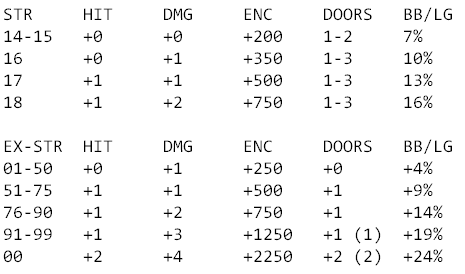This game design grease monkey has been under the hood of 5e tearing it apart to figure out how to get it to run like 1e, preferably with strictly DM-facing house rules, and only the minimum of those. And let me tell you, this XP advancement has problems. So many in fact that rejecting XP completely and surrendering to milestone leveling is extremely common.
Refer to PHB 15 for character XP required to level up, DMG 82 for expected XP budgets to build an encounter, and MM 9 for XP by CR.
When you throw the tables into Excel it seems like they were constructed in a totally arbitrary fashion.
Fig. 1: XP advancement by level, with the equal-level CR monster’s XP value, and how many of those monsters the party will need to defeat to level up.
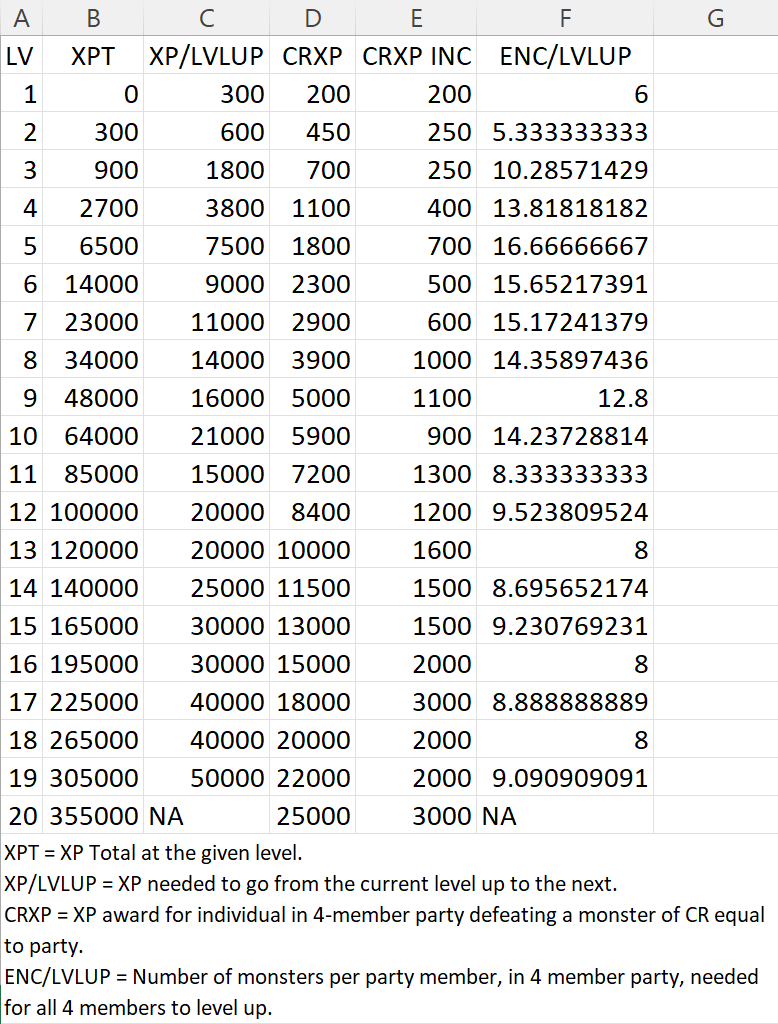
Let’s also look at the chart of columns D, E, F.
Fig. 2 CRXP
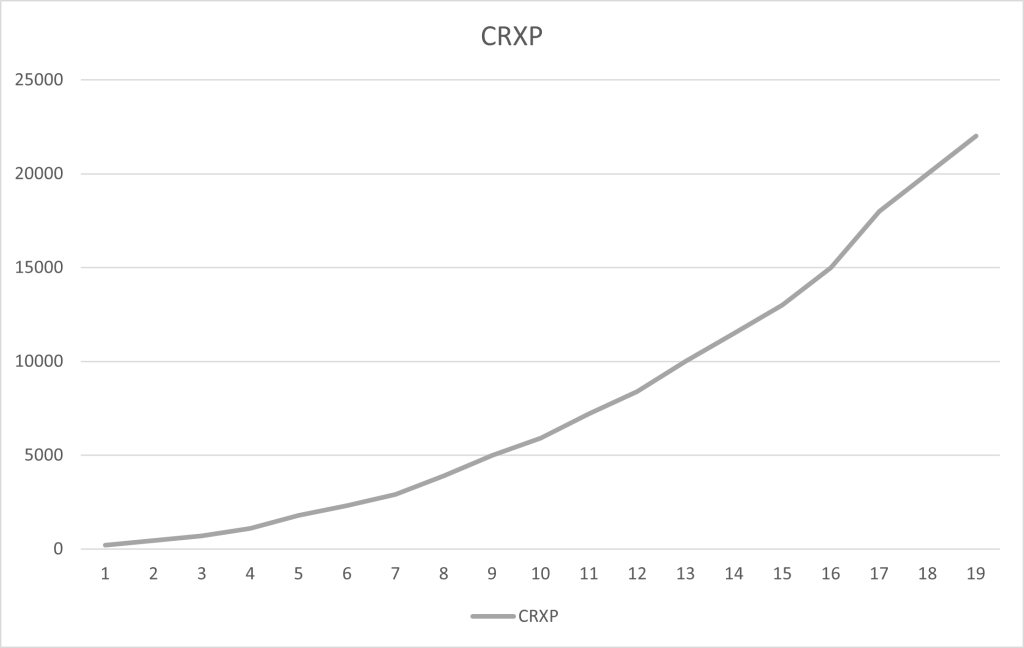
Fig. 3 CRXP INC
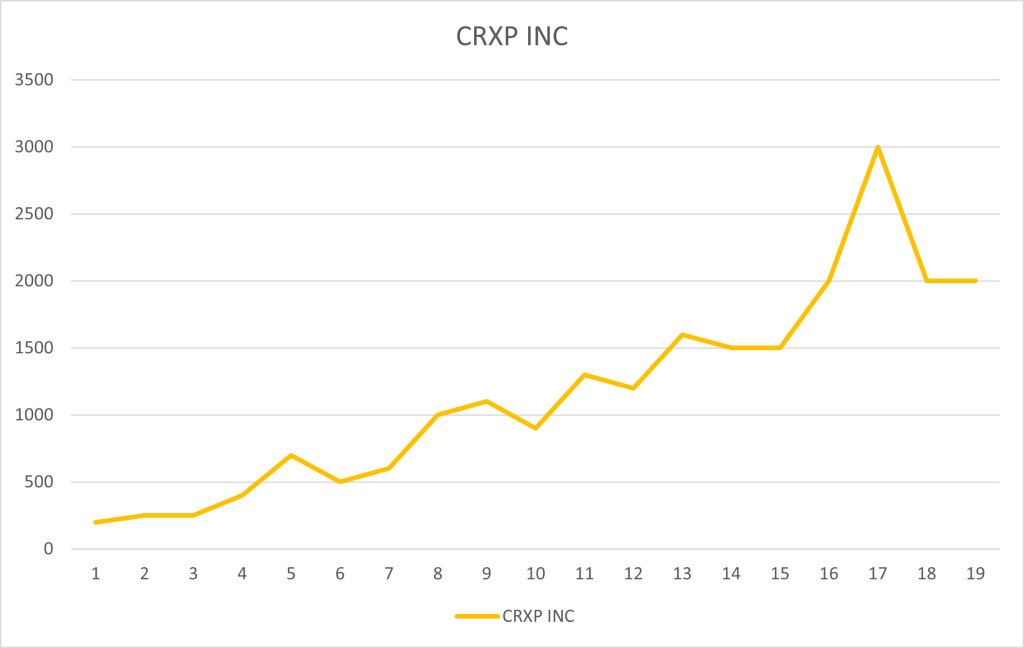
Fig. 4 ENC/LVLUP
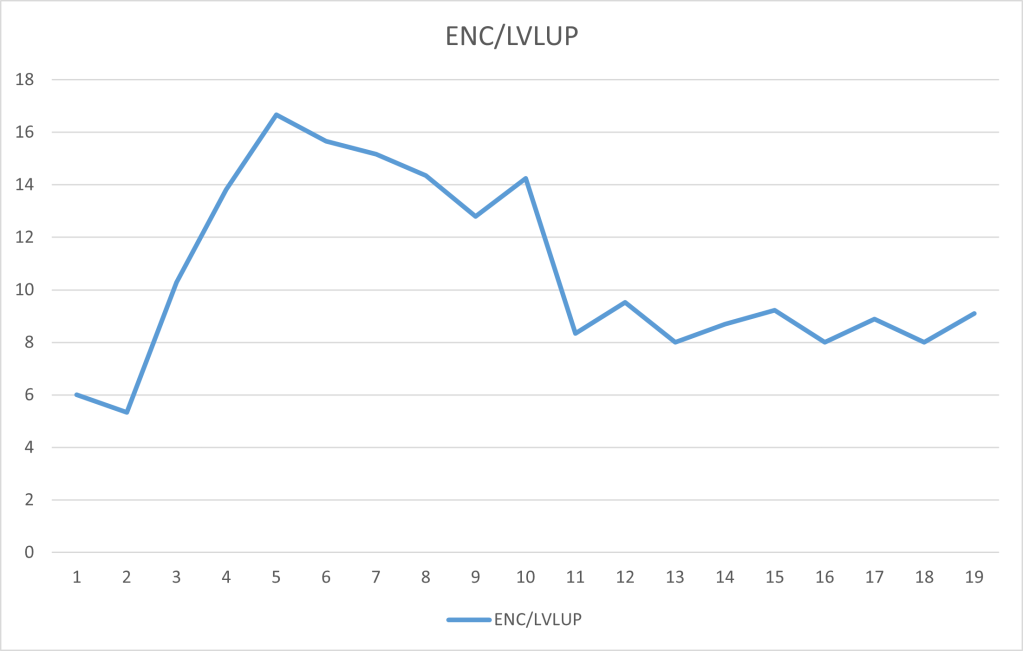
Assumptions
Let’s assume, first, the tables were well-considered and the outcomes are intentional. Second, from these charts we can deduce intentional game design imperatives. Third, I am assuming that the CR assigned to monsters is realistic to describe the purported difficulty.
From Fig. 2 it looks like there was an effort at smoothing the XP awarded by CR. Designer probably used a formula to generate 20 numbers, then had to manually adjust most of them to achieve clean round memorable numbers.
From Fig. 3 we see that the increase in CR does not follow the curve. That becomes important when you look at the data in Fig. 1 and look up the dips. What the chart is suggesting is that the XP value (the reward commensurate with the challenge) increases in a jagged counterintuitive way that is only acceptable if the actual challenge actually increases in the same weird way.
From Fig. 4 we see the way the CR values impact actual advancement. Leveling at levels 1 and 2 is extremely fast, becoming more difficult at 3, and spiking into the teens from 5-10. Then advancement speed swoops to a fast single-digit number of encounters through to 20th.
What we must assume is that either (a) the designer thought that low-level PCs would fight very low-CR monsters, way under their numerical weight class, and so would earn XP slower and end up taking just as long to level. And also that after 10th PCs would rarely be fighting encounters of their level, instead just waltzing through lower-level encounters. Or (b) that the designer felt players would consider levels 1-2 and 10+ really boring, and it’s best to speed up advancement during those times.
Regardless of the intent, do we want that?
Time Spent At Level
5e was balanced to broaden the “sweet spot” where it’s easy to build appropriate adventures and the game contains rich content. In 1e for example this sweet spot feels like 3rd-14th to me. Low-level play involves low-level hazards and treasure, and many players and DMs are eager to get into what they perceive to be the meat of the game. Usually, in doing so they’re signaling boredom with or non-use of such lowbie challenges as adventuring supplies like food, climbing, darkness, holding your breath, encumbrance, having to walk everywhere, etc.
I think advancement should be fairly smooth in terms of gameplay per level-up. And some time should be spent at-level before rising. If content is available to be experienced, players ought to be given the chance to experience it at or close to the intended level. They also should have time to enjoy and understand their newly acquired abilities and power level, which means testing those against known and novel challenges in the campaign. Wizards for example ought to spend enough time with a given spell level to acquire new and interesting spells and explore the uses of the current ones before gaining access to the next spell level.
Consider too that this is exacerbated by the length of game sessions; previously an 8-hour game session was normal, while these days people meet on a weeknight for 3 hours. And many groups will burn through Level 1 in those first 3 hours and meet up next week (or next month?) at Level 2.
5e focuses on improving low-level gameplay by bumping up 1st level PCs and tamping down later levels. It makes sense then not to rush through low levels. Elsewhere besides the XP chart the game is signaling that levels 1-3 can be fun and spending time there is worthwhile.
Video games have established a pattern of easy early rewards, especially level-up, to the point that some video games consider leveling up to be part of the 5-minute tutorial. I’ve played games with a 1-100 level scale where leveling to 8th in the first play session is easily achievable. This doesn’t continue linearly, though; the designer intends to make you jolt yourself with dopamine and form an attachment to the game before advancement slows down to acceptable rates through level 40 and then to a crawl thereafter. It’s all part of the Skinner Box game design philosophy.
But D&D is a game for friends, there’s no need to use psychological trickery to addict players, and there’s no profit motive to do it. And it certainly doesn’t make the game better to cause fast advancement at low level; if a group wants to skip levels 1-3, why not just start at 4th?
There’s an NPC demographic problem too. Adventuring needs to be a process fraught with hazard and uncertainty, otherwise peasants would flow into dungeons to make a few hundred GP or die trying (especially when the alternative is working your limbs to the bone in slavery to the turnip harvest). And it needs to be slow because whatever achievement the PCs reached in a year of adventuring is probably about what every other adventuring group, mercenary company, military unit, and ship crew managed – or at least a quarter that XP if they’re actively avoiding adventure instead of seeking it out. I don’t want a frontier town to have 8th level pawnshop owners and innkeepers. But what applies to PCs will apply to NPCs, which means leveling up has to take a little while.
The House Rule
Looking back at my house rule imperative, I want this to be DM-side. This is because a particular character should be portable into the campaign or out of it, and player shouldn’t have to fill their PHB with amendment slips.
The math is also easier if we adjust XP values for each CR instead of adjusting the XP advancement table. Use my Fig. 1 above, use column C “XP/LVLUP”, and divide that by the number of encounters you want the party to face to gain a level. If you want to follow the RAW table in Fig. 1 and expect 202 even-CR encounters to reach 20th, that smooths out to 10 even-CR encounters per level. Then CR 1 XP value needs to be 120 XP (30 per PC). CRs below 1 have fractional awards as usual. If you think there should be a breakpoint at each play tier, where it should take 10 encounters at Tier 1 (Level 1-4), 12 at Tier 2 (5-10), 14 at Tier 3 (11-16) and 16 at Tier 4 (17-20) then you know what to do. If you think the advancement speed of 5e is blazing fast and you prefer 3e’s 13 encounters per level (which includes hazards like traps), or 1e’s roughly 18 encounters per level (including treasure XP), use that denominator.
REMEMBER to still consider CR as-written for purposes of balancing encounters. Just because less XP is awarded doesn’t mean you have more monsters in your encounter budget.
Fig. 5 House-Ruled CR XP by Encounters Needed Per Level-Up
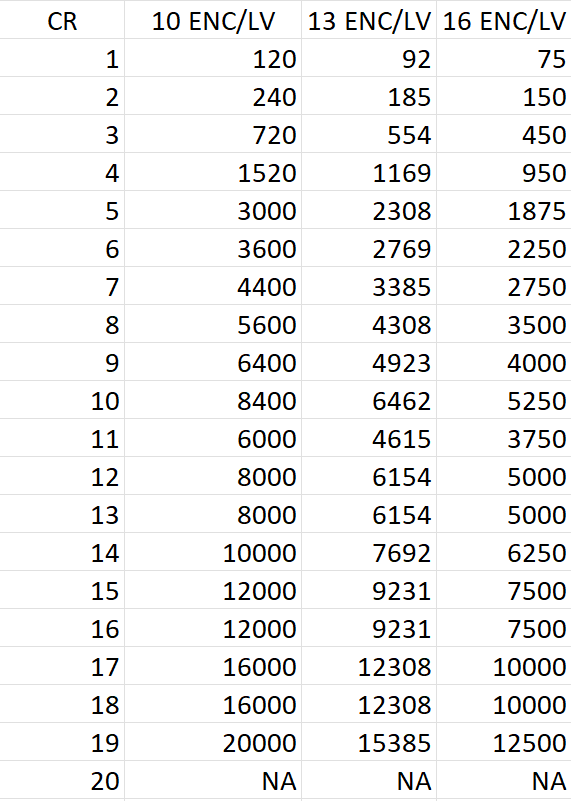
By the way, this also highly devalues monsters CR 2 and under, while normalizing later monsters, because the XP advancement chart requires so little XP at level 1 and 2 that those CRs will be of negligible value to high-level PCs. Which makes sense, because they’re also of negligible threat to a high-level party with area-effect spells and good AC.
My plan is to include an “ad hoc” XP award for discovering treasure on an adventure. I want treasure XP to be roughly 75% of the total, monster XP 25%. Not that you’d see all that treasure carried by those monsters; getting the loot with less risk is part of the player skill, and treasure will be generally scattered in forgotten corners or held in lairs. Wandering monsters offer threat and burn resources but little or no treasure. And I can place more treasure that’s well-hidden and might not be found except by very thorough players. I don’t want advancement to be as slow as 1e, so let’s assume a 1:13 rate.
So for my example, I would want a typical adventure for a 4-person party of 1st level characters to contain CR 1/4 and 1/2 enemies, maybe a CR 1 “boss” monster and/or maybe a CR 2 optional (if you don’t take it out at this PC level, but clear the rest of the dungeon first, it probably leaves with its loot to inhabit some worse neighborhood before you can beef up and return). The 4 CR 1s contribute 368 XP to my total, the 16 CR 1/2s contribute 736 XP, the 32 CR 1/4s contribute 736 XP. Total is 1,840. If they take out the CR 2 optional it’s worth another 185 XP, 10% of the rest of the adventure!
But if I want to do treasure XP, I should rejigger the table instead of recalculating all the time. 23 XP per CR 1, with the understanding that there’s also 69 XP worth of treasure elsewhere in the adventure. Since the CR 2 is worth 46 XP for defeat, I want to put the related 139 XP worth of treasure in its lair so you have to address that particular monster to get that hoard.
Treasure XP
In 1e treasure XP is 1 XP per GP value. I suspect the XP advancement tables were built with a certain amount of loot in mind so that the very easy 1:1 XP:GP standard would still work. Unfortunately, it means a very large amount of treasure beyond level 10 is necessary to proceed at the same advancement rate. However, perhaps by design, the XP needed to gain each level past “name level” (about 10th) is flat, meaning that if treasure accumulation doesn’t speed up considerably then neither will level advancement, but if accumulation remains steady then advancement will too. That is, slowing advancement beyond name level would have demanded faster accumulation to compensate.
Regardless, I need magic item sale values which 5e was not kind enough to supply, which means I’ll fall back on1e and 3e values and gauging how different items are from those other versions to come up with a value. Others have done this, https://forums.giantitp.com/showthread.php?424243-Sane-Magic-Item-Prices being one, and I’ll have to review to see if any of them are a good starting point for me. Ideally I want to have values similar to 1e because I have written a LOT of material that’s 1e compatible.
Because 5e XP advancement is rather different from 1e, it will mean I might not be able to use a 1:1 ratio for treasure XP. At level 1, there’s a 1:7 XP advancement difference from 1e (fighter) to 5e. Over level 1-20 it averages out to about 1:5. Looked at another way, suggested Wealth By Level guidelines from 3e compared to 5e XP advancement hover close around 1 GP/XP to 0.75 GP/XP, with major outliers at levels 2-4 (5e would be too rich) and 17-20 (5e would be too poor). Which suggests that I could just write low-level adventures/areas that have less treasure and more monsters. Or put forth more single-use consumable magic items at low level vs. permanent ones, because if something gets used up it no longer affects WBL. If a party is too rich at levels 2-4 it’s also not a huge deal because that imbalance gets muddled in the numbers of the next couple of levels. It’s just a possible problem of building inaccurate player expectations. Some combination of the three might conceal the problem at low level and let me go with a 1:1 award.
How To Do It Differently
So many of the problems I’m encountering relate to very low XP requirements for leveling at 1-3, and if I were willing to adjust the players’ XP chart I could fix several things on my end at once. But I think it’s worth me going through more effort so that players can still refer to their PHB, characters remain portable, etc.

